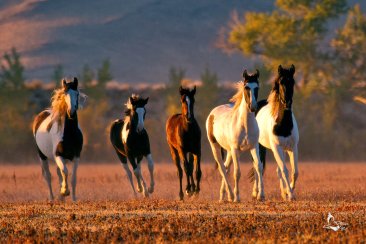The arrival of Spanish Conquistadores in the 15th Century on land that is now part of Mexico began the most enduring American symbolism and mythos that endures to this day: the wild mustang. Today, thanks to urban sprawl, farmland development, and cattle grazing, much of the land these wild horses thrived on has been part and parceled to a huge extent, leaving tens of thousands of horses and burros with a grossly small land percentage on which to roam and graze. From 1971 to 2012 alone, the land acreage dropped from 53.8 million acres to just 31.6 million acres. And that doesn’t count the millions more acres that were lost in the early half of the 20th Century with the unprecedented westward migration of tens of thousands of farmers.
The Bureau has been essential to protecting the last open grazing land from any kind of private or corporate buyouts that could lead to even more destruction of what remains part of the unmolested plains ecosystem. From 1971 when President Nixon signed the Wild Free-Roaming Horses and Burros Act into law, to the creation of the National Adopt-A-Horse and Burro Program in 1976, the establishment of four Wild Horse Ranges (Little Book Cliffs Wild Horse Range, Pryor Mountain Wild Horse Range, Nevada Wild Horse Range, and Marietta Wild Burro Range), and most recently the wide reaching reforms in wild horse and burro herd population management, the BLM has certainly put a great effort into preserving natural grazing lands and monitoring the health of wild herds.
So how can the BLM step up to the plate to ensure the long life of the land without sacrificing the humane treatment of the animals who live there? For one, the Humane Society of the United States proposes an extremely viable solution that will not only ease the stress on the grazing land but will also greatly lower the growth of overpopulation, lessen the need and number of horses and burros rounded up each year, and will do so with far less stress and cruelty to the animals. The proposal: fertility control. The BLM even stated in its 2011 Fundamental Reform that it hopes to significantly increase the number of mares treated with fertility drugs, from 500 to about 2000. Fewer pregnancies mean fewer foals, mean smaller herds, means proper land balance. Just as important, the BLM continues to oppose the selling of horses and burros to slaughter and intends to improve both short and long-term holding facilities to ensure the health and happiness of the animals living there.
As these stunning animals and the rugged and, as of yet, untamed lands they live on are such an important part of our history and environment, we shouldn’t be afraid to speak up about protecting them. Contact your local state legislators about the issue or get involved through the Humane Society of the United States, the National Mustang Association, and The Wild Horse Preservation Campaign. The issue might not be in your personal backyard, but it’s a part of our national backyard and deserves your attention and action.
